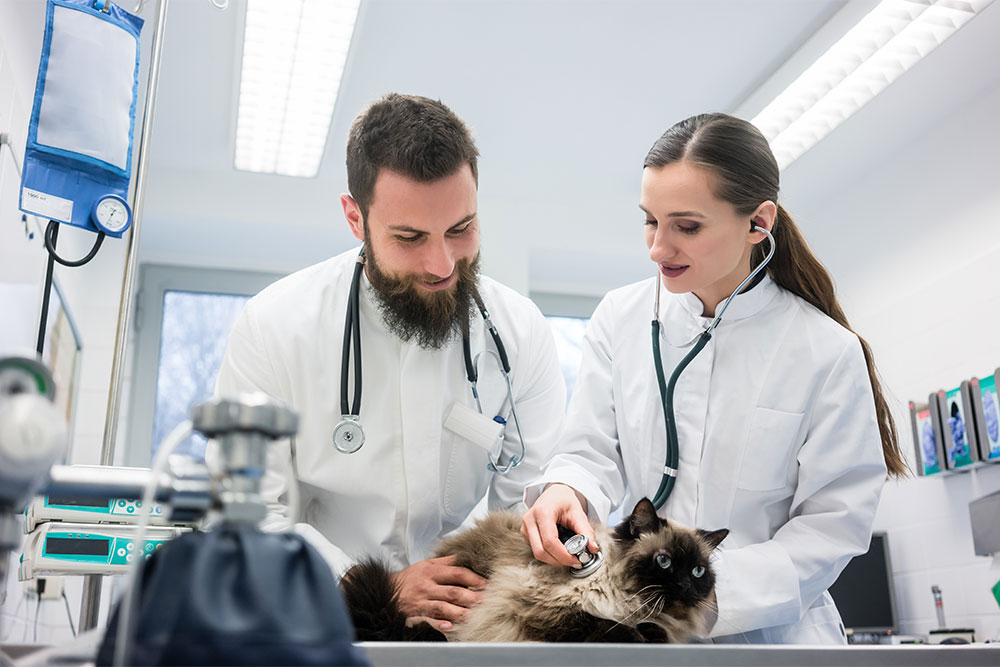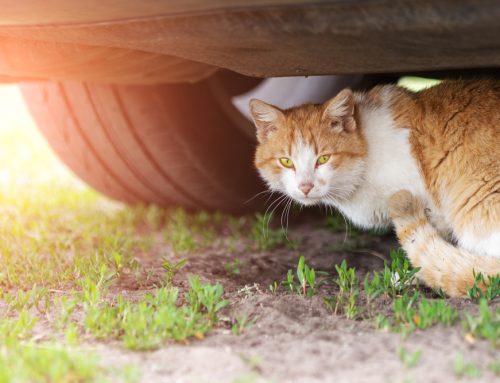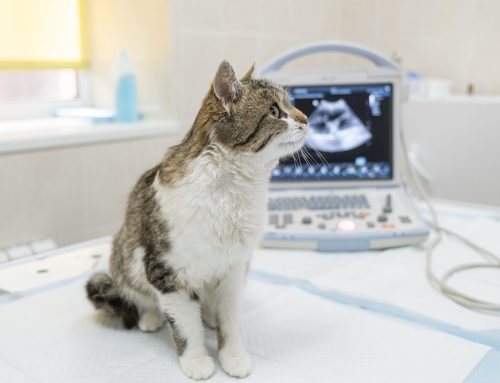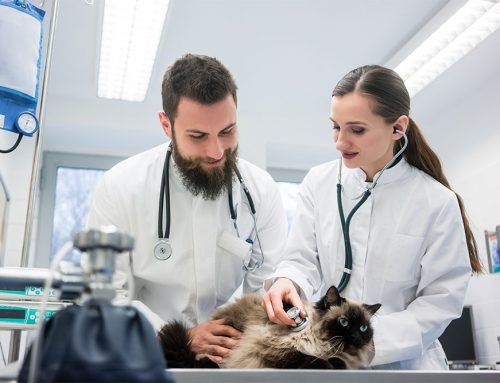When a curious pet swallows a pill that rolled under the sofa or licks a puddle of antifreeze in the driveway, panic sets in fast. We know the sinking feeling that follows—our own hearts race right alongside yours. At Omega Veterinary Group in San Mateo, California, our intensive care team manages toxin cases every week, and we want you to feel prepared long before an emergency strikes.
Is This Really an Emergency?
Not every upset stomach is life-threatening, but some dangers can’t wait. The American Animal Hospital Association’s guide, Help! Is This a Pet Emergency? lays out red-flag signs such as seizures, collapse, persistent vomiting, or trouble breathing. If you notice any of these symptoms—or even just have a strong suspicion your pet reached something toxic—call us or head to the nearest 24-hour hospital right away.
Where Do Poisons Hide?
1. Inside the Medicine Cabinet
Many pet medications are flavored and chewable- making them a delicious and dangerous feast to have all at once. Many pets are curious about human medications- after all, they see you hold the bottle and eat the contents, so why shouldn’t they try too?
2. On the Dinner Table
Chocolate tops the list—Halloween Safety: Chocolate Toxicity in Pets outlines why even small amounts can cause heart arrhythmias. Grapes, raisins, onions, garlic, xylitol, alcohol, and raw bread dough are other repeat offenders.
3. In the Yard or Garage
Rodenticides are extremely common in the Bay Area. Read “Rodenticide and Your Pet: What You Need to Know” to understand why just one block can cause internal bleeding. Pesticides, fertilizers, mushrooms, and de-icing salts create additional risk. For plant lovers, the ASPCA maintains a searchable list—see “Toxic and Non-Toxic Plants” before you landscape.
4. Recreational or Illicit Drugs
Legal cannabis edibles smell delicious to pets. “Keeping Pets Safe from Marijuana” reviews the rising number of THC poisonings. Stronger substances—opioids, amphetamines, cocaine—produce life-threatening neurologic signs; the Merck Veterinary Manual’s page on “Toxicities from Illicit and Abused Drugs” covers the mechanisms in detail.
5. Everyday “Chew Toys”
Electrical cords, batteries, and remotes seem unpalatable, yet pets do chew them. AAHA’s list “Don’t Chew On This!” highlights overlooked items and the mouth injuries—or heavy-metal toxicity— they cause.
How to Spot Trouble Early
- Gastrointestinal: sudden drooling, retching, diarrhea, blood in stool
- Neurologic: tremors, stumbling, hyperactivity, seizures, coma
- Cardiorespiratory: panting, wheezing, irregular heartbeat, collapse
- Other clues: pale gums, yellow eyes, extreme thirst, unusual urine color
Because different poisons act at different speeds, symptoms might appear minutes or days later. If you’re unsure, the Emergency Care Resources for Pet Owners page from the AVMA can help you decide while you head for professional care.
Step-by-Step Care in Our ICU
- Telephone Triage
Our nurses collect the product name, ingredient list, time of exposure, and any home remedies already attempted. We often call the experts at ASPCA Poison Control for a case-specific protocol while you’re still en route. - Stabilization on Arrival
• Oxygen supplementation for breathing difficulty
• Intravenous catheters for fluids, dextrose, or life-saving antidotes
• Continuous ECG and blood-pressure monitoring - Decontamination
If the substance is still in the stomach and safe to bring back up, we induce vomiting or perform gastric lavage. Activated charcoal, an oral suspension, traps many chemicals before they enter the bloodstream. For topical toxins (think motor oil or permethrin flea products), we clip fur and bathe—gently, because burned skin is painful. - Targeted Antidotes and Advanced Therapies
- Vitamin K1 reverses certain anticoagulant rodenticides.
• Intravenous lipid emulsion binds fat-soluble drugs like marijuana and local anesthetics.
• Hemodialysis or peritoneal dialysis supports kidneys after antifreeze or NSAID overdose.
• Plasma transfusions control bleeding.
• Mechanical ventilation supports lungs after smoke-inhalation injury. - Long-Term Monitoring
Even when outward signs resolve, liver or kidney enzymes can spike days later. We schedule repeat lab work and, when needed, ultrasounds to track healing.
What If Treatment Is Delayed?
Untreated toxin exposure may progress to:
- Acute kidney failure (grape, antifreeze, or NSAID ingestion)
- Liver necrosis (xylitol, cyanobacteria)
- Cardiac arrest (chocolate, amphetamines)
- Neurologic impairment (metaldehyde slug bait, ivermectin in some herding breeds)
- Coagulopathy and internal hemorrhage (rodenticides)
Beyond physical damage, many pets emerge anxious, nauseous, or weak, needing weeks of quiet recovery and behavior support.
Life at Home During Recovery
- Nutrition: Offer bland meals in small, frequent portions unless otherwise directed.
- Hydration: Provide fresh water in multiple bowls; some pets prefer a fountain.
- Comfort: Dim lighting and soft bedding reduce sensory overload for neurologic patients.
- Medication: Use pill organizers to prevent missed or doubled doses.
- Observation: Keep a notebook of appetite, urine output, and demeanor; odd changes often surface first at home.
Prevention Blueprint
- Audit Every Room
The AAHA article “Essential Tips for Pet-Proofing Your Home” is a great checklist. Start with the kitchen trash can, move to bathroom cabinets, and end in the garage. - Read Labels Like a Pharmacist
Over-the-counter meds, herbal supplements, and even vitamins can spell trouble. The FDA’s “Potentially Dangerous Items for Your Pet” dives into hidden hazards. - Secure Outdoor Spaces
Choose pet-safe ice melts and pesticides. Fence off compost heaps that grow mold. Review the ASPCA plant database each spring before buying new greenery. - Smart Disposal
Return old medications to a pharmacy take-back box. Never pour chemicals into the street where rainwater can pool. - Training and Enrichment
A bored animal explores with its mouth. Rotate puzzle feeders, schedule daily walks, and block off “no-pet” zones with baby gates.

Quick Tips & Tricks
- Keep a laminated list of household toxins on the fridge.
- Store the ASPCA Poison Control number (888-426-4435) in every family member’s phone.
- Pack an emergency “go bag” with hydrogen peroxide (for vet-directed emesis), slip leash, towel, and medical records.
- Use childproof locks on low cabinets—even agile cats struggle to open them.
FAQs
Can I safely induce vomiting at home?
Only after you speak with a veterinarian. Caustic substances, oils, or sharp objects can burn or tear the esophagus on the way back up.
How fast do I need to act?
Within 30 minutes for most oral exposures is ideal, but some slow-acting toxins still benefit from treatment hours later. When in doubt, seek help.
Will my pet need to stay overnight?
Many toxin cases require 24- to 72-hour hospitalization for IV fluids, serial lab work, and observation. We allow scheduled visits to ease your anxiety and your pet’s stress.
What will this cost?
Expenses vary widely. We provide a written estimate and discuss high-priority treatments first, then optional add-ons so you can make informed decisions.
We’re Here When You Need Us
Toxin emergencies can feel overwhelming, yet with quick action and professional care, most pets recover fully and return to their normal routines. If you have any concerns, please reach out and contact us, learn more about the skilled clinicians who will care for your pet on our team page, or explore the full list of services we provide. We’re committed to supporting both you and your pet—every hour of every day.






Leave A Comment